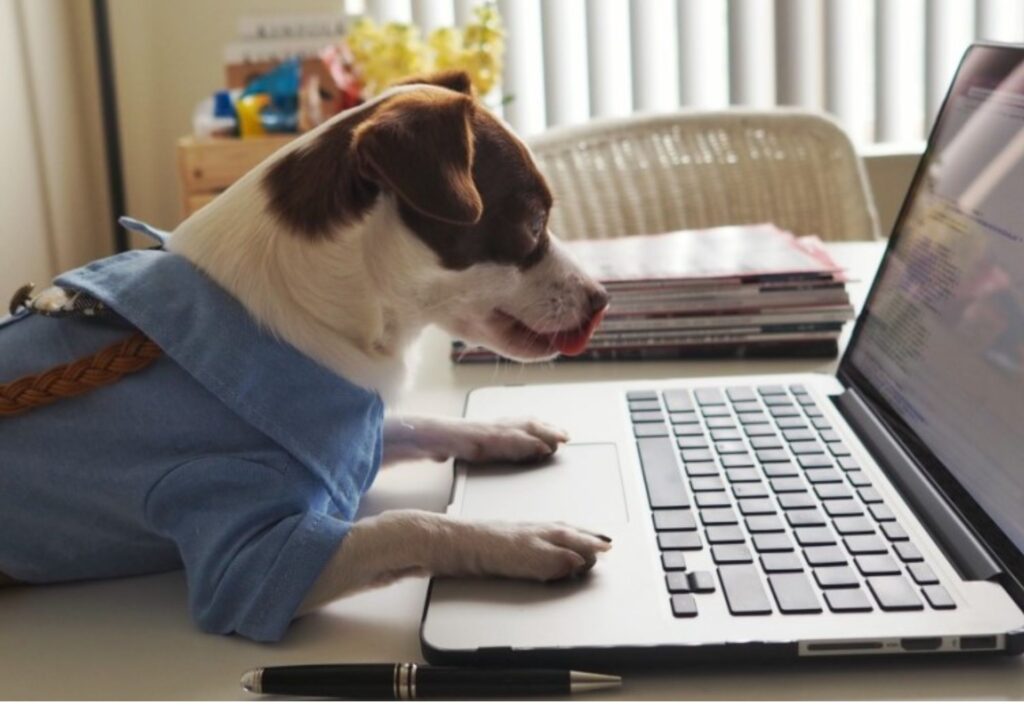Blog
Teaching Dogs to Use Laptops
Teaching a dog to use a laptop might seem like an impossible feat, but with patience and the right approach, it’s possible to engage your canine friend in some tech-savvy activities. While dogs may not be able to perform complex tasks like coding, you can train them to interact with a laptop in fun and creative ways. This guide will walk you through the steps to teach your dog to use a laptop, including essential tips, techniques, and safety considerations.
Link Domain https://javanet247.com/
Understanding Your Dog’s Abilities
Before you start training, it’s important to understand that dogs have different abilities and levels of intelligence. While they may not be able to grasp complex concepts, they can be trained to perform specific actions and respond to commands. Keep in mind that the goal is not to make your dog a tech expert but to create a fun and interactive experience.
Preparing the Training Environment

Creating the right environment is crucial for successful training. Here’s how to set up an ideal space for teaching your dog to use a laptop:
- Choose a Comfortable Space: Select a quiet, comfortable area where your dog feels relaxed. This could be a spot in your living room or a designated training area.
- Set Up the Laptop: Place the laptop on a stable surface at a height that is accessible to your dog. Ensure that the laptop is powered on and ready for use.
- Eliminate Distractions: Minimize distractions in the training area to help your dog focus on the task at hand. Turn off other electronic devices and keep the environment calm.
Training Techniques
Training your dog to use a laptop involves patience, positive reinforcement, and consistency. Here’s a step-by-step approach to get started:
- Introduce the Laptop: Allow your dog to explore the laptop at their own pace. Let them sniff and investigate the device to get comfortable with it.
- Associate the Laptop with Treats: Place treats or favorite toys near the laptop to create a positive association. This will help motivate your dog to interact with the device.
- Teach Basic Commands: Start with basic commands like “touch” or “paw.” Encourage your dog to place their paw on the laptop’s keyboard or touchpad. Reward them with treats and praise for their efforts.
- Use Clicker Training: Clicker training is an effective method for reinforcing desired behaviors. Use a clicker to mark the exact moment your dog interacts with the laptop. Follow the click with a treat to reinforce the behavior.
- Encourage Specific Actions: Gradually introduce specific actions, such as pressing a key or tapping the touchpad. Guide your dog’s paw to the desired location and reward them when they successfully perform the action.
- Increase Difficulty: As your dog becomes more comfortable, increase the difficulty by introducing more complex actions. For example, you can teach them to press multiple keys or interact with specific icons on the screen.
- Practice Regularly: Consistency is key to successful training. Schedule regular training sessions to reinforce the behavior and keep your dog engaged.
Training Tips

- Be Patient: Training takes time and patience. Don’t rush the process or expect instant results. Celebrate small victories and keep the sessions short and enjoyable.
- Use Positive Reinforcement: Reward your dog with treats, praise, and affection to encourage desired behaviors. Positive reinforcement helps create a positive learning experience.
- Keep Training Fun: Make training sessions enjoyable by incorporating play and rewards. Use toys or treats to keep your dog motivated and engaged.
- Adjust Training to Your Dog’s Personality: Every dog is unique, and training methods should be adapted to their personality and learning style. Be flexible and adjust your approach based on your dog’s response.
Safety Considerations
When training your dog to use a laptop, it’s important to ensure their safety and well-being. Here are some safety considerations to keep in mind:
- Avoid Overexposure: Limit the amount of time your dog spends interacting with the laptop. Prolonged exposure to screens can cause eye strain and discomfort.
- Monitor Interaction: Supervise your dog’s interaction with the laptop to prevent accidental damage or injury. Ensure that the laptop is securely placed and that your dog doesn’t chew on cords or other components.
- Check for Allergies: Be aware of any potential allergies or sensitivities your dog may have to materials used in the laptop or accessories. Consult with your veterinarian if you have any concerns.
Fun Activities to Try

Once your dog is comfortable using the laptop, you can explore some fun activities:
- Interactive Games: Use software or apps designed for dogs to provide interactive games and activities. These games can stimulate your dog’s mind and provide entertainment.
- Video Calls: Set up video calls with friends or family members and let your dog interact with the screen. This can be a fun way for your dog to see and hear familiar faces.
- Digital Art: Experiment with digital drawing tools or apps that allow your dog to create digital art by interacting with the touchpad or screen.
External link: art.htmlhttps:/jetluxury.techarmz.com/transformed-celebrity-
Conclusion
Teaching your dog to use a laptop is a creative and engaging way to bond with your pet and provide mental stimulation. By understanding your dog’s abilities, preparing the right environment, and using effective training techniques, you can create a fun and interactive experience. Remember to be patient, use positive reinforcement, and prioritize your dog’s safety throughout the training process.
With dedication and creativity, you and your dog can enjoy the benefits of a tech-savvy companion. Whether it’s pressing keys, interacting with digital content, or simply exploring the laptop, the experience can be both rewarding and enjoyable for both you and your furry friend.

